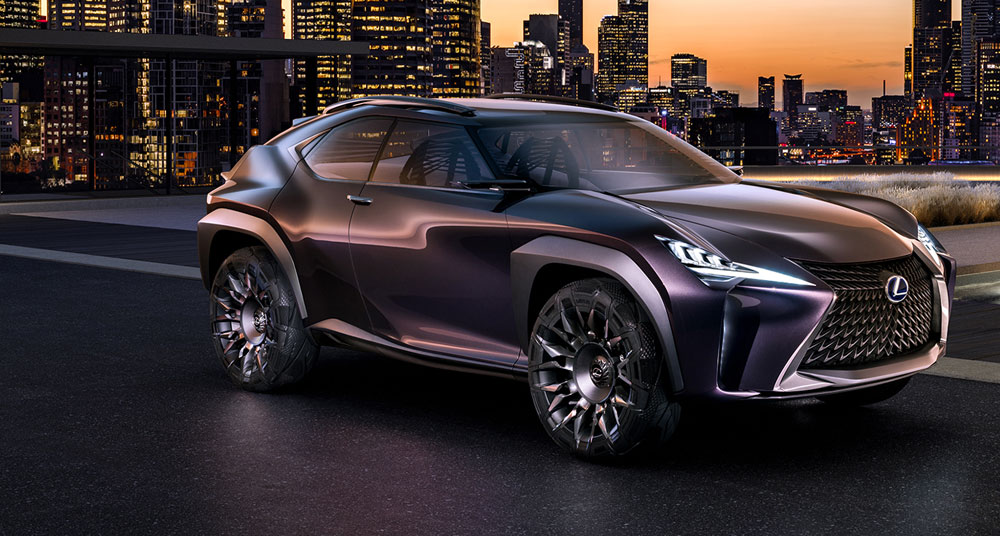
Lexus has debuted their new UX crossover concept at the Paris Motor Show, and first up is the press release — here’s the full, unabridged version, weighing in at 2,000 words.
PARIS (September 29, 2016) – Showcasing Lexus’ vision for a compact SUV of the future, the UX Concept will make its world debut at the 2016 Paris Motor Show. Designed by ED2, Lexus’ design center in the South of France, the UX Concept represents a new step in the company’s design journey and a redefinition of the driving experience.
“The biggest challenge for any designer is always to create something new and original, yet with relevance to both the customer and the brand. Overall, this is a product which gives another hint of the potential for Lexus’ design approach to satisfy those criteria. The expression of a progressive, strong yet artistic, and premium product which further enhances Lexus’ unique and challenging brand position.” – Simon Humphries, President of ED2
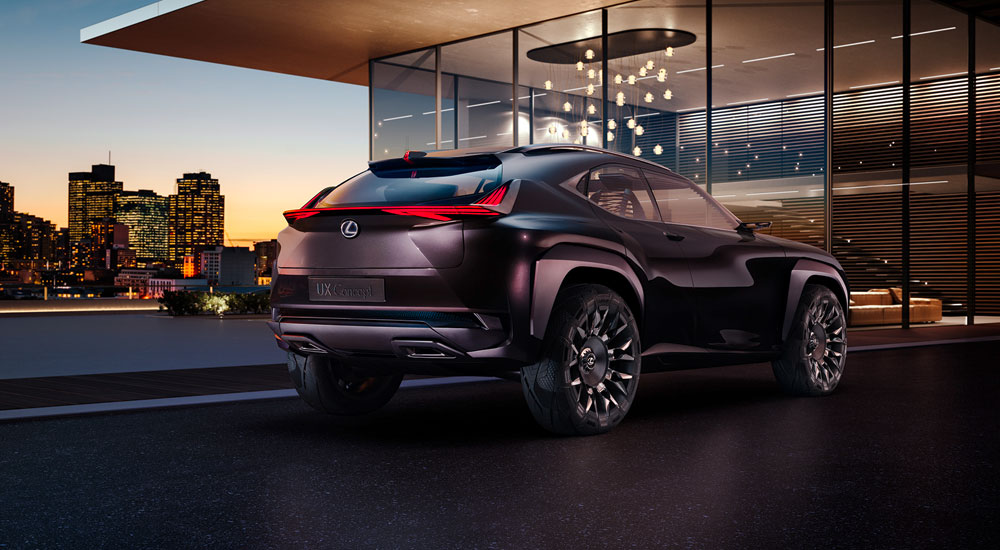
A powerful reinterpretation of the Lexus design signatures, the UX Concept reflects the brand’s determination that each of its models should have a unique, standalone character with a strong concept behind it; represented here by the powerful, “inside-out” design concept and deconstructed interior styling. This bold design embodies imaginative, forward-thinking technologies to provide occupants with a fully immersive experience. This sensation is generated through cockpit ergonomics which flow from the driver’s body, and innovative three-dimensional HMI technology.
The vehicle also features a first design execution of a breakthrough seat technology, the Kinetic Seat Concept, designed by Lexus in response to a re-evaluation of the principles of car seat occupancy.
The entry luxury SUV segment is the fastest-growing luxury segment in the U.S. Thanks to two groups— young customers upgrading in the quest for distinctive styling, a versatile interior, and an engaging driving experience, and premium customers looking for an impressive, high-function interior in a vehicle sized for urban living. The UX Concept highlights Lexus’ intention to attract an ever-wider group of new, younger, ever-connected urban customers (“Urbanites”) to the brand for the first time.
RADICAL COMPACT CROSSOVER PACKAGING
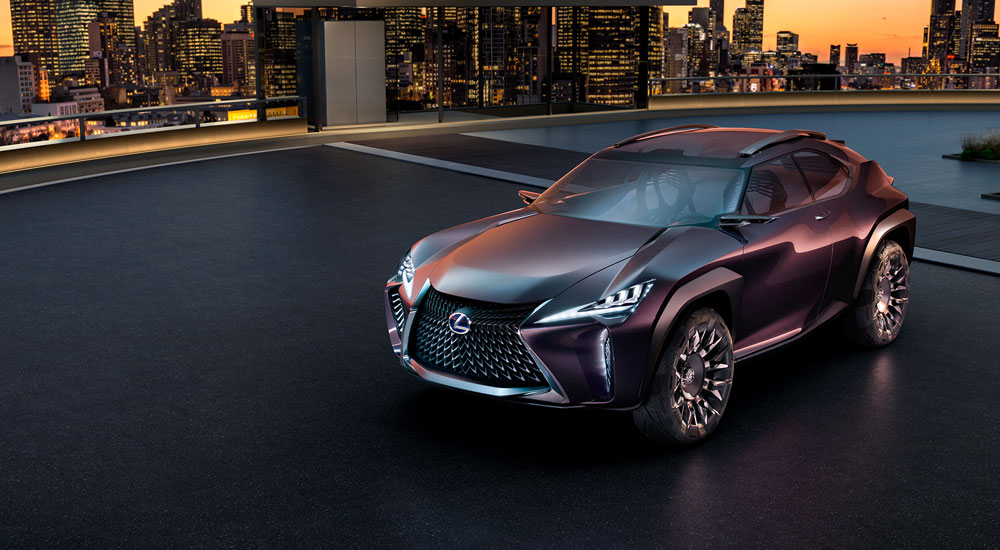
“Our brief was to create a new genre of compact crossover; a vehicle that could progress the user experience and create something unique from a customer’s point of view. Inspiration came from many sources, but the main source of inspiration comes from the key phrases representing the character of the car: ‘robust yet agile’ and ‘inside-out styling concept’. This comes from one of the Lexus fundamentals, the ‘Yet’ philosophy. We were looking for inspiration representing the synergy of contrasting values, in architecture, fashion design or nature, with a view to fusing lightness, structural, artistic and emotional values.” – Stephan Rasmussen, Exterior Designer, ED2
The UX Concept is a new variety of four-seater crossover which contrasts the appearance and 4×4 presence of an off-roader with a low ground clearance and a coupe-like driving position, reinforcing the dynamic performance promise embedded in the compact packaging of the design.
UNIQUE “INSIDE-OUT” DESIGN CONCEPT

“The ‘inside-out’ concept came from a lot of discussions within the team. We wanted to show the human- centric aspect of the concept in a visually as well as philosophically strong way. A strong symbiosis between the exterior and interior was felt to be important by all the designers involved. To create the anticipation from the exterior, which could then have a visual link and expand into the interior, was a key goal.”- Alexandre Gommier, Interior Designer, ED2
At the heart of the design lies a futuristic, “inside-out” concept which creates a strong synergy between exterior and interior styling. In top view, this is most strongly represented by an X-shaped movement in the architecture from the cabin outwards and vice-versa.
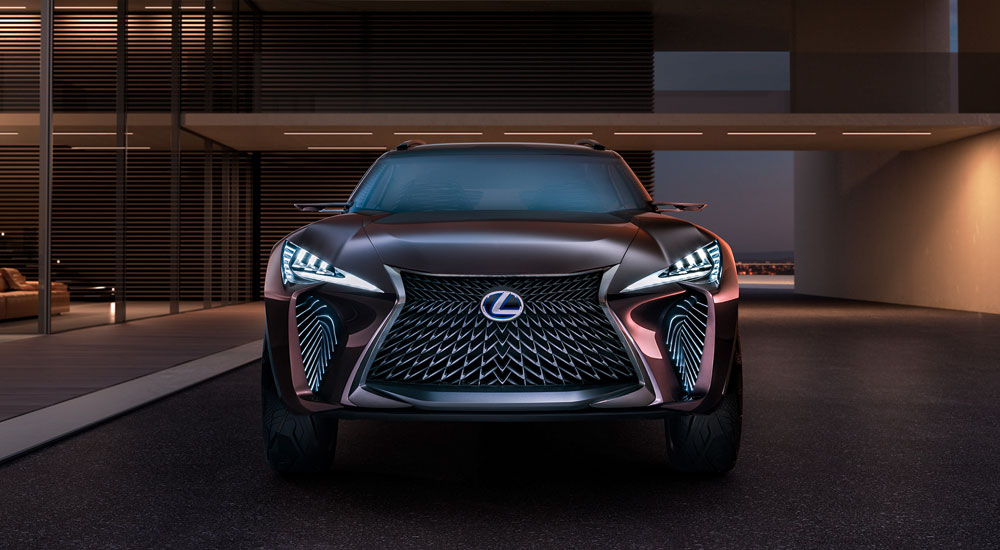
In the front, the car’s fenders flow seamlessly into the cabin to form housings for e-mirror screens showing the image from door-mounted, rear-facing cameras. The dashboard top sits lower than these screens to combine a deconstructed look with excellent forward visibility. To the rear, the bodywork again flows into the cabin, forming the main structure of the rear-seat headrests.
X-shaped movement from the inside outwards is similarly reinforced through the 4×4 style emphasis of the powerful fenders, with aerodynamically efficient wheel arch cladding adding a further dimension to the design.
VISIBLE INNER SKELETON
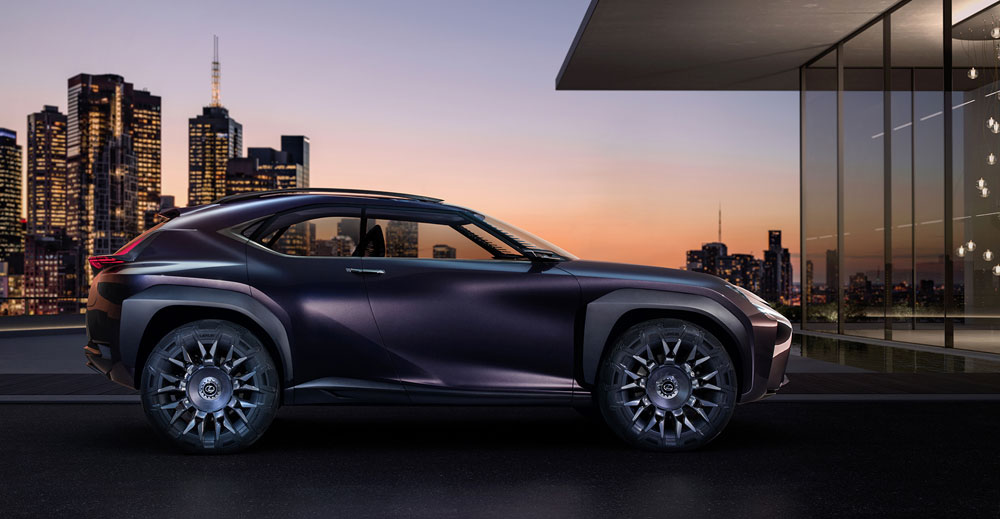
The “inside-out” styling theme is further emphasized by the wheel arches, roof bars, and door cameras. They are all finished in the same material, and represent a form of continuous yet interrupted bone structure. For example, the inner skeleton of the vehicle coming into view as the roof bar penetrates the cabin—creating the A pillar structure—and re-emerging as the door camera mounting.
HIGHLY SCULPTURAL FLUID DESIGN
“We worked extensively in clay as well as digital methods; not to be the most efficient, but to be able to achieve the best quality of surfacing and design. Having a highly skilled Takumi clay modelling team on the project allowed us to explore many ways to create the beautiful surface interactions that are a key element to this design’s muscular yet elegant boldness.”- Stephan Rasmussen, Exterior Designer, ED2
A further evolution of the Lexus spindle grille marks an important step forward, wherein the whole volume surrounding the grille creates the identity of the vehicle—a more three-dimensional starting point which informs the shape of the body shell. These key external elements are linked together by highly sculptural surfaces reminiscent of a classic sports car.
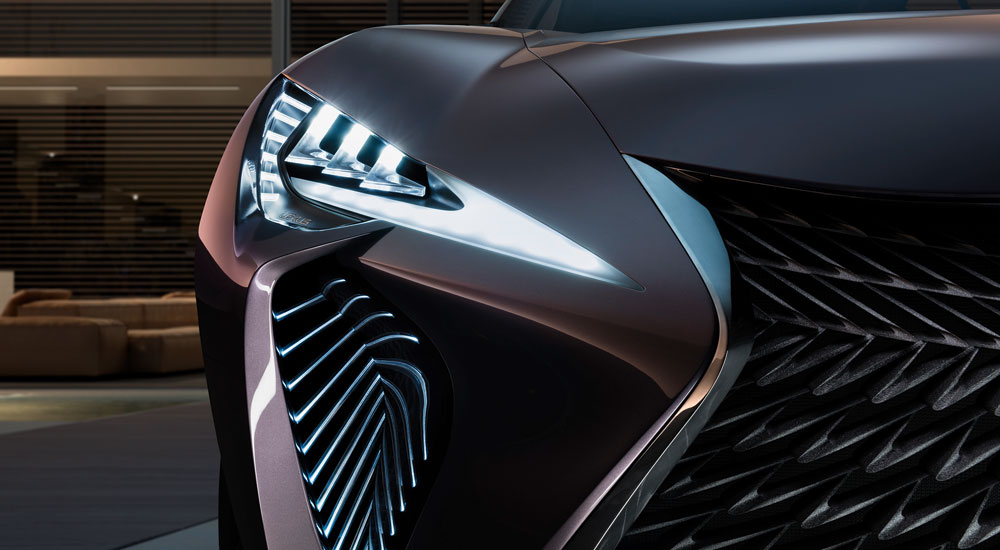
This architecture is unique to Lexus; a bold horizontal design is achieved through volume rather than merely character lines, where the sum of those lines equals the horizontal axis of the car. From the side, the length of the hood further emphasizes the strong linear aspect of the design, while the peak of the cabin is deliberately set back to create a dynamic and characteristic profile.
FORM-DEFINING PAINTWORK
Even the body color has been designed to emphasize the shape of the car. In the absence of character lines, the multi-layered depth of the newly-developed “Immersive Amethyst” paintwork serves to highlight volume changes, giving definition to the sculpture and expressing the car as a volume rather than simply a line-oriented design.
INNOVATIVE DESIGN SIGNATURE DETAILS
The “inside-out” concept is not merely reflected in the overall architecture of the design, but also in numerous exterior and interior details throughout the vehicle, many of which represent a more challenging interpretation of several Lexus design signatures.
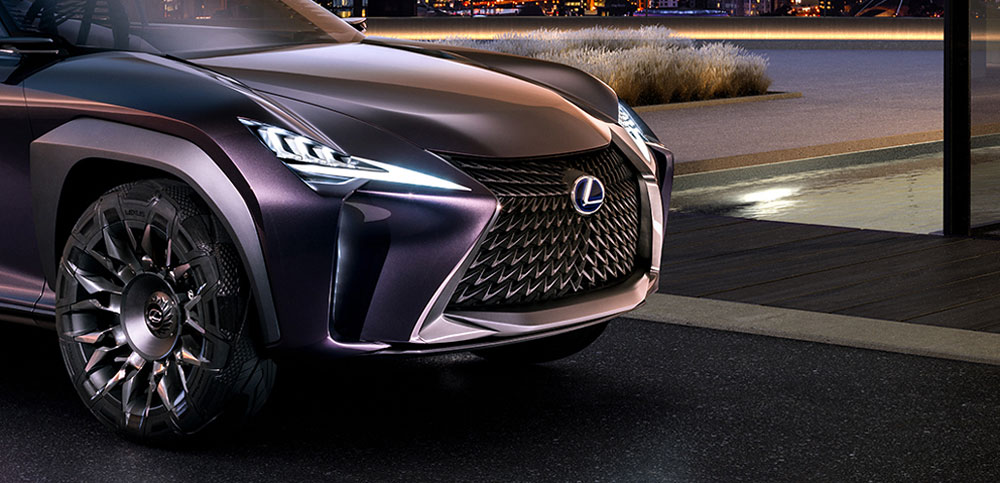
The L-shaped Daytime Running Lights (DRL) are now positioned to pierce the main lamps, and the rear lamp design is now more three-dimensional and integrated within the rear spoiler. Together, the front and rear lamps create a strong horizontal axis through the vehicle body. In an evolution of the DRL principle, light fibers spanning the air vents at the front bumper’s edges are a similar design to the grille pattern. The mesh pattern of the grille itself spreads radially outwards from the logo and is picked up by the adjacent light fibers, emphasizing the width of the car and giving it an even stronger road presence.
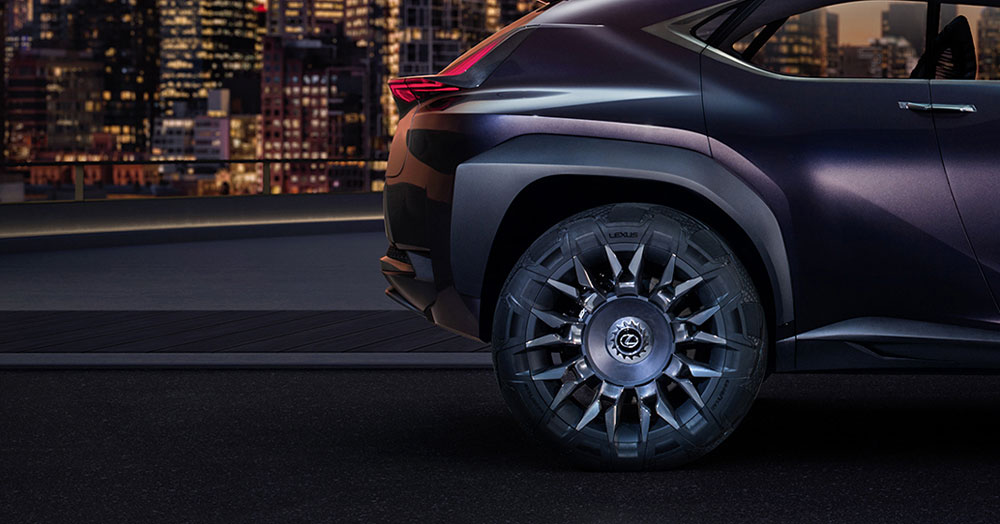
Even the unique tires blur the accepted boundaries of materials and continue the “inside-out” theme. The tire design is created using a hi-tech laser carving processes to express two unique aspects. The dynamic tread pattern maximizes road contact for grip, while the side wall emphasizes a crossover feel through unique sections and seamless integration with the wheel design. A section of the wheel continues into the rubber, making the spokes a visual joint between different sections of tire; the result is the appearance of the wheel and tire as one, rather than separate elements.
UNIQUE, SEE-THROUGH A PILLAR
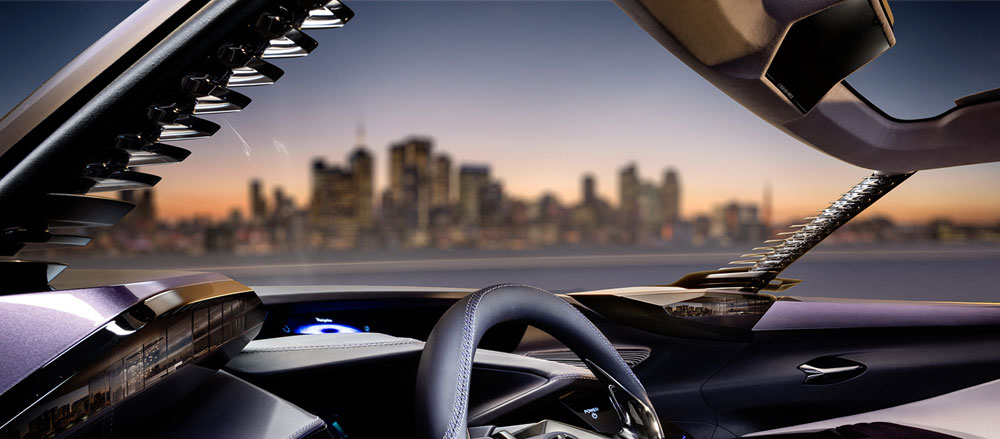
A unique, “see-through” A pillar serves to blur the boundaries between the exterior and interior. While the creation of a fully-transparent polycarbonate A pillar is feasible, the UX Concept communicates the message of transparency through the use of polycarbonate fins attached to an aluminum member.
TWO PERCEPTIONS OF LUXURY IN ONE CABIN
Signaled by the sharp, aggressive front and softer, more welcoming rear fender exterior treatments, the cabin of the UX offers two different perceptions of luxury.
The front represents agile sophistication and driver engagement, the rear—styled as a welcoming, soft lounge sofa which wraps around into the hinged back doors—the comfort and spaciousness of a robust SUV. Linked both by a central axis console element which floats the full length of the cabin and the visual transparency of a unique front-seat design, interior space differences are further reinforced by color scheme. The front cabin is dark, to communicate a premium, driver-focused environment, while the back of the car is light and far brighter to create an attractive, welcoming space.
DECONSTRUCTED INTERIOR
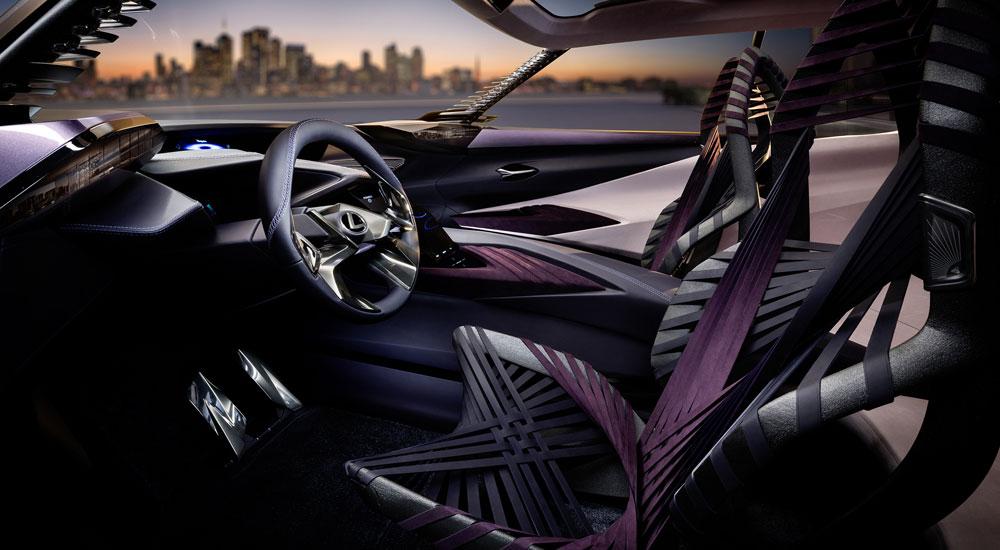
“Deconstruction” is a second key design principle employed in the Lexus UX Concept. This is most powerfully represented in the front of the cabin where, in place of a conventional dashboard, sharp, angular forms overlap and flow past each other to create a strong interplay of shadows and contrasts, making it difficult to identify where they begin or end.
This particularly Japanese approach to design suggests that, to create a fixed point, you merely have to indicate its hypothetical position with converging lines and the brain fills in the gaps to create that point in the mind. Such “indirect expression”—the premise that you don’t actually need to be able to see something to understand it is there—lies at the heart of Lexus’ L-finesse design philosophy.
Within this unique, deconstructed interior, a strong “seat in control” principle remains a Lexus brand signature. And the front passenger area was deliberately not prioritized in order to emphasize the driver’s control of the environment.
IMAGINATIVE 3-D TECHNOLOGY
A development of Lexus’ dual-zone instrumentation approach, all on-board HMI technology has been designed to offer progressive customers who live and work in an ever-connected environment an innovative and three-dimensional driver experience.
The upper display, for example, is projected in such a way that it appears at a far-distance, for ease of viewing when driving. The driver’s instrument binnacle houses a transparent globe, floating in the manner of a hologram, in which a combination of analogue and digital information express a functional yet unexpected user interface. And the center console houses a prominent, facetted crystal structure within which a hologram-style display of air conditioning and infotainment system is clearly visible to both driver and front passenger.
LATEST ADVANCED IN-VEHICLE TECHNOLOGIES
The latest advanced in-vehicle electrical technologies are also on display in the new Lexus UX Concept. It features electro-chromatic windows, and the door mirrors are replaced by e-mirror camera housings far slimmer than conventional mirror housing.
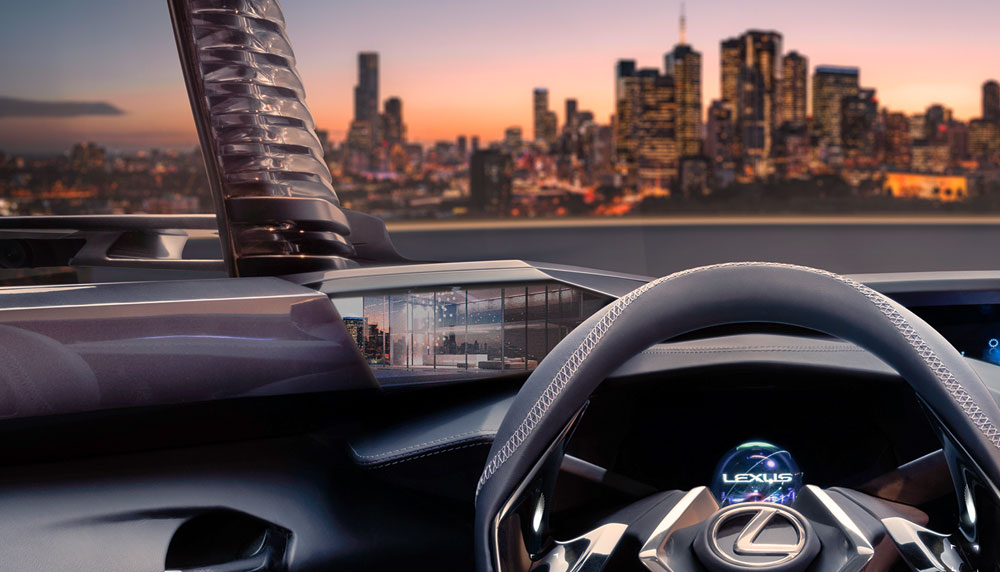
Left and right e-mirror images are displayed on internal screens, the integration of which—rather than serving as a mere detail—contributes to the entire “inside-out” architecture of the dashboard design. All switchgear is electrostatic, and housed under transparent covers. The front passenger, who has a different experience of the instrument panel to that of the driver, has a separate center display track pad control built into the door armrest panel.
As a final touch, the fin motif used on the A pillar is repeated on the dashboard to provide a new audio experience for the next-generation Lexus customer: a removable sound bar built into the passenger side of the dashboard.
A NEW APPROACH TO DRIVING ERGONOMICS
In a new departure for Lexus’ Human Machine Interface (HMI) concept, the ergonomics of the cockpit area flow from the driver’s body, via the seat, up to the steering wheel, rather than from a traditional dashboard layout. Combined with innovative, three-dimensional HMI technology, this design approach creates a uniquely immersive driving experience.
SPECIFICATIONS
- Length: 173.2 inches
- Height: 59.8 inches
- Width: 74.8 inches
- Wheelbase: 103.9 inches
- Seating Capacity: Four
- Wheels and Tires: Unique 21″ tire and wheel fusion 255/50/R21